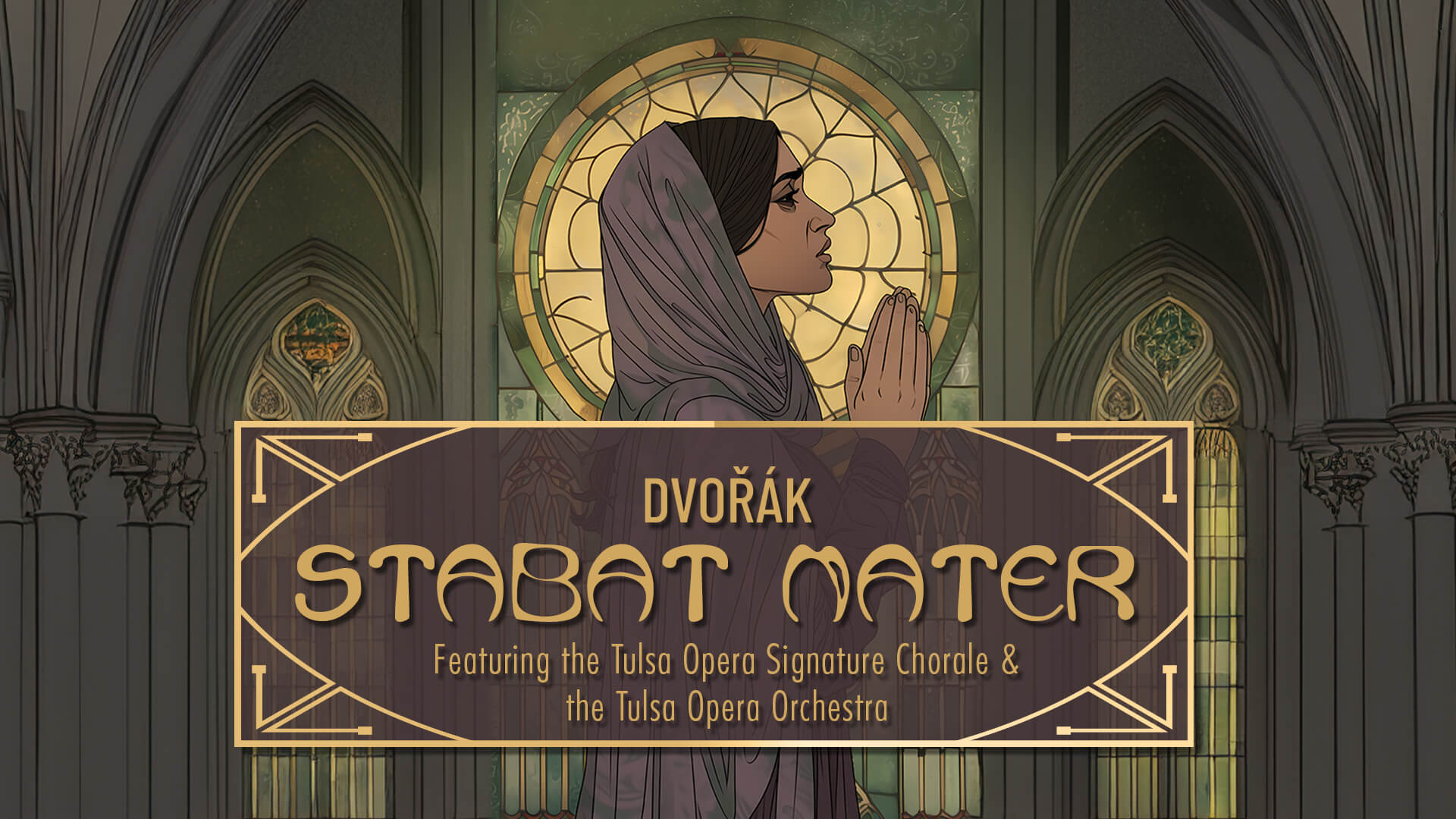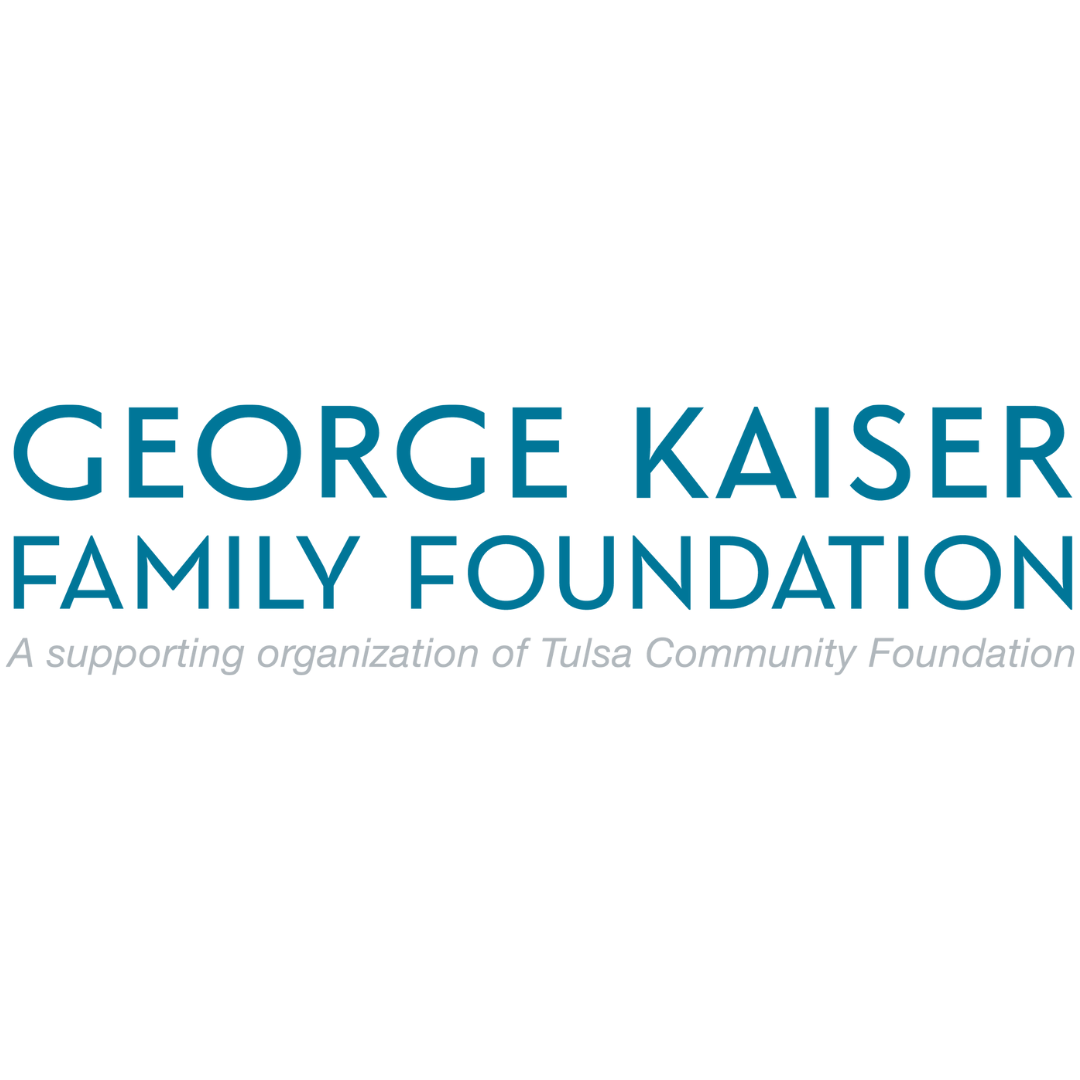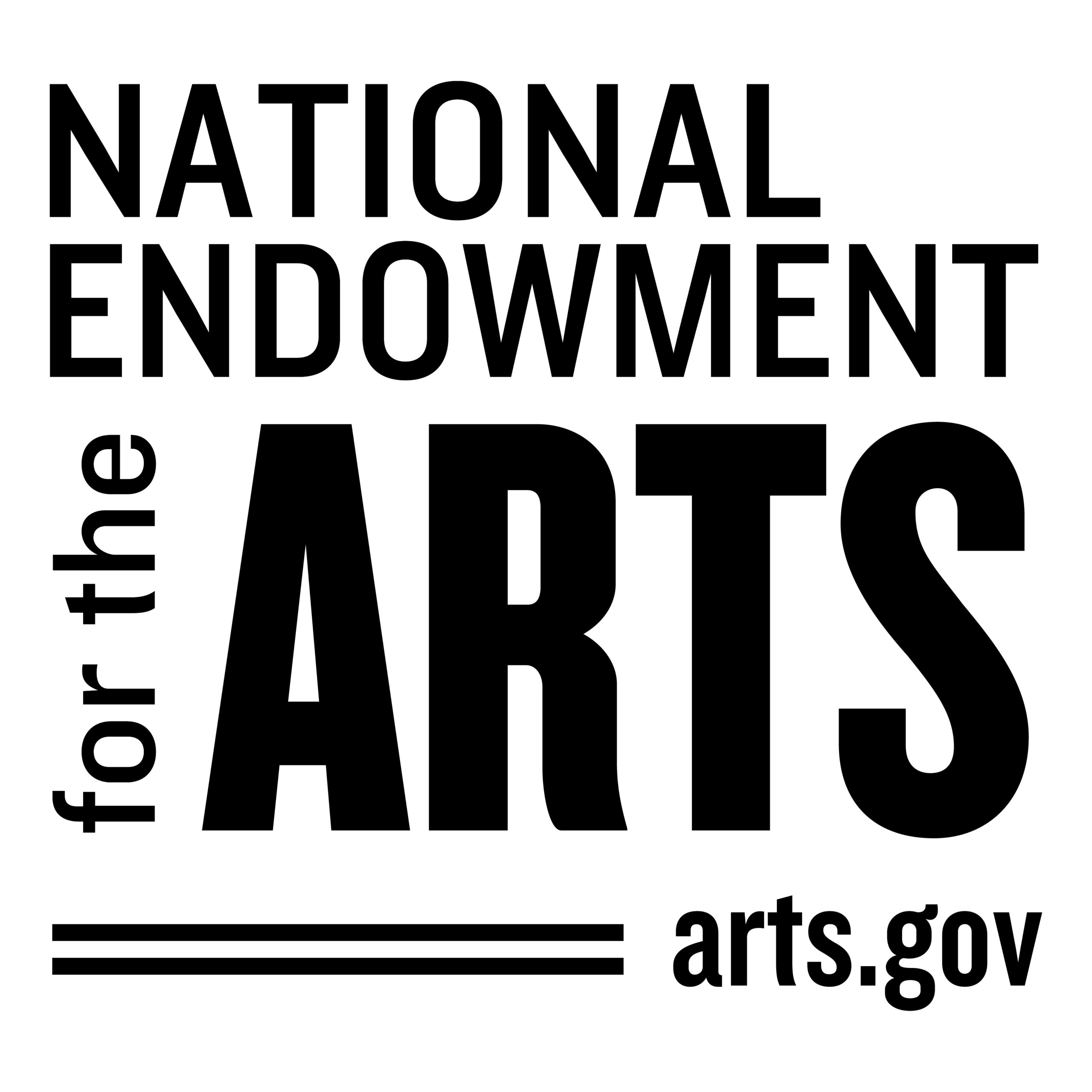
Dvořák Stabat Mater
Aaron Beck, conductor
featuring the
Tulsa Opera Signature Chorale
& the Tulsa Opera Orchestra
Friday, April 26, 2025
7:30 pm
Holy Family Cathedral
820 South Boulder Ave. West
Tulsa, OK 74119
Program Notes
Antonín Dvořák’s Stabat Mater is a profound meditation on grief and faith, composed in response to devastating personal losses. Between 1875 and 1877, Dvořák suffered the heartbreaking deaths of all three of his children. This work, born from his sorrow, transcends personal tragedy to express a universal yearning for comfort and hope. In a world still grappling with challenges and loss, the Stabat Mater resonates deeply, reminding us of the transformative power of music in uniting and uplifting the human spirit.
This concert aligns beautifully with Tulsa Opera’s commitment to presenting works that reflect the breadth of human experience. The Stabat Mater brings together the Tulsa Opera Signature Chorale and Tulsa Opera Orchestra, along with distinguished soloists, in a celebration of community and artistic excellence. Its themes of compassion and renewal resonate powerfully within our season’s offerings, inviting listeners to connect through shared emotion and reflection.
Selecting this piece was deeply personal. Its transcendent melodies and heartfelt expression have always moved me, and it feels especially fitting to present it in Holy Family Cathedral. The cathedral’s sacred and acoustically rich space elevates the experience, enveloping listeners in Dvořák’s luminous soundscape.
We extend our heartfelt gratitude to Holy Family Cathedral for their generosity in allowing us to perform in this inspiring venue. Their support ensures that this music reaches its fullest potential, creating an unforgettable experience for us all.
Thank you for joining us this evening. May this performance bring you moments of peace, reflection, and inspiration.
-Aaron Beck, Conductor & Artistic Director
About the Stabat Mater
The Stabat Mater is a 13th-century Latin hymn that gives voice to the Virgin Mary’s sorrow as she stands beneath the cross of her dying son. Traditionally attributed to the Franciscan poet Jacopone da Todi, the poem became one of the most beloved and widely set texts in Christian sacred music. Over centuries, composers have returned to its powerful imagery and emotional resonance, drawn by its balance of grief and devotion, anguish and transcendence.
Rather than telling a story in the narrative sense, the Stabat Mater unfolds as a spiritual and emotional journey. The text opens with Mary’s visible suffering, then turns inward, inviting the listener to share in her sorrow, to feel the wounds of Christ, and to be changed by compassion. It concludes with a prayer for grace, redemption, and eternal peace.
Though written in the medieval period, the Stabat Mater still speaks to modern hearts. Its enduring legacy is rooted not only in its sacred origin, but in its deep humanity: it is a cry of mourning, a plea for empathy, and an act of hope.
-Aaron Beck, Conductor & Artistic Director
Translations
Movement I
Stabat Mater dolorosa
iuxta crucem lacrimosa
dum pendebat Filius.
Cujus animam gementem
contristatam et dolentem
pertransivit gladius.
O quam tristis et afflicta
fuit illa benedicta
Mater unigeniti.
Quae moerebat et dolebat
pia Mater, dum videbat
nati poenas inclyti.
The Mother of Sorrows
stood weeping by the cross
while her Son was hanging.
Whose grieving soul,
sorrowful and suffering,
was pierced by a sword.
How sad and afflicted
was that Blessed
Mother of the Only-Begotten.
The pious Mother mourned and suffered
as she watched the torment
of her glorious Son.
Movement II
Quis est homo qui non fleret
Christi Matrem si videret
in tanto supplicio?
Quis non posset contristari
Christi Matrem contemplari
dolentem cum Filio?
Pro peccatis suae gentis
vidit Iesum in tormentis
et flagellis subditum.
Vidit suum dulcem Natum
moriendo desolatum
dum emisit spiritum.
Who is there who would not weep
to see the Mother of Christ
in such agony?
Who would not be moved to sorrow
to contemplate the Mother of Christ
suffering with her Son?
For the sins of His people,
she saw Jesus in torment,
subjected to scourging.
She saw her sweet Son,
dying, forsaken,
as He gave up His spirit.
Movement III
Eja Mater, fons amoris
me sentire vim doloris
fac ut tecum lugeam.
O Mother, Fountain of Love,
let me feel the strength of your sorrow,
that I may grieve with you.
Movement IV
Fac ut ardeat cor meum
in amando Christum Deum
ut sibi complaceam.
Sancta Mater, istud agas,
Crucifixi fige plagas
cordi meo valide.
Make my heart burn
with love for Christ my God,
that I may please Him.
Holy Mother, grant this:
fix the wounds of the Crucified
deeply in my heart.
Movement V
Tui nati vulnerati
tam dignati pro me pati
poenas mecum divide.
Let me share in the suffering
of your wounded Son,
who deigned to suffer for me.
Movement VI
Fac me vere tecum flere
Crucifixo condolere
donec ego vixero.
Iuxta crucem tecum stare
te libenter sociare
in planctu desidero.
Let me truly weep with you,
to mourn the Crucified
for as long as I live.
I desire to stand beside the cross with you,
to join you freely
in your mourning.
Movement VII
Virgo virginum praeclara
mihi iam non sis amara
fac me tecum plangere.
Glorious Virgin of Virgins,
do not be harsh with me;
let me weep with you.
Movement VIII
Fac ut portem Christi mortem
passionis fac consortem
et plagas recolere.
Fac me plagis vulnerari
Cruce hac inebriari
ob amorem Filii.
Grant that I may bear the death of Christ,
make me a partner in His Passion,
and remember His wounds.
Wound me with His wounds,
let me be intoxicated by the Cross,
for the love of your Son.
Movement IX
Inflammatus et accensus
per te, Virgo, sim defensus
in die iudicii.
Fac me Cruce custodiri
morte Christi praemuniri
confoveri gratia.
Inflamed and ignited,
may I, through you, O Virgin,
be defended on the Day of Judgment.
Let me be guarded by the Cross,
strengthened by Christ’s death,
and comforted by grace.
Movement X
Quando corpus morietur
fac ut animae donetur
Paradisi gloria. Amen.
When my body dies,
grant that my soul may be given
the glory of Paradise. Amen.
Soloists
 Paige Grilliot Dickey*+, soprano
Paige Grilliot Dickey*+, soprano
Jennifer, I Love You, You’re Perfect, Now Change (Tulsa Opera); Mother, Amahl and the Night Visitors (Tulsa Youth Opera); Mrs. Gobineau, The Medium (Tulsa Opera); Filstrup Resident Artist – Laven Sowell Artist
 Justin Kroll*+, tenor
Justin Kroll*+, tenor
Nemorino, L’elisir d’amore (Landlocked Opera); Larry, The Face on the Barroom Floor (Tulsa Opera); Hajný, Rusalka (Opera Idaho); Filstrup Resident Artist – Laven Sowell Artist
 Mark McCrory, bass-baritone
Mark McCrory, bass-baritone
Montano, Otello (Dallas Opera); Marco, A View from the Bridge (Lyric Opera of Chicago); Don Basilio, Il barbiere di Siviglia (Tulsa Opera)
 Mary Ann Stewart, soprano
Mary Ann Stewart, soprano
Baker’s Wife, Into the Woods (Tulsa Opera); Madame Flora, The Medium (Tulsa Opera); Thérèse Raquin, Thérèse Raquin (Long Beach Opera and Chicago Opera Theatre)
*Filstrup Resident Artist
+Laven Sowell Artist
The Tulsa Opera Signature Chorale
SOPRANOS
Rachel Bloomer
Heather Brower
Deborah Burdette
Brenda Bussman
Danielle Carlotti-Smith
Ginelle Gordon
Svetlana Gortseva
Jennafer Jacob
Sarah Linde
Doreen Linder
Jamie May
Chrissy Mayer
Carla Smith
ALTOS
Leah Armstrong
Maddie Breedlove*
Christina Citty
Rachel Dodson
Janice Drummond
Gwen Fleske
Rachel Kim
Aerielle Michell
Paulette Record
Zoya Ridenour
Karlena Riggs*
Casey Sorber
Rose Wallace
TENORS
Damian Alberti
Tavia Armstrong
Tim Davis
David Fleske
John Ford
Celyn Grigson
Danielle Kennedy-LaReau
Debby LeMaster
James Mathew
BASSES
Andre Carrington
Paul Cox
David Curry
Jim Gordon
Nicholas Hoover
Robert Lane
William Smiley
*Filstrup Resident Artist
The Tulsa Opera Orchestra
VIOLIN I
Gina Davis, Concertmaster
Paulo Eskitch, Associate Concertmaster
Patti Gaddis
VIOLIN II
Sheri Scales-Neubauer*
Dominique Corbeil
Martha Mattes
VIOLA
Jeff Cowen*
Phil Wachowski
CELLO
Kari Caldwell*
Krassimira Figg
BASS
Marc Facci*
FLUTE
Juliana Overmier*
OBOE
Lise Glaser*
CLARINET
David Carter*
BASSOON
Richard Ramey*
HORN
Derek Matthesen*
TIMPANI
Steve Craft*
ORCHESTRA LIBRARIAN
Marc Facci
*Principal
The Tulsa Opera Orchestra operates under an agreement with the American Federation of Musicians local 94.
Artistic Team & Production Crew
 Aaron Beck, Conductor and Tulsa Opera Signature Chorale Director
Aaron Beck, Conductor and Tulsa Opera Signature Chorale Director
Conductor: The Snow Queen (Tulsa Youth Opera); Amahl and the Night Visitors (Tulsa Youth Opera); Rossini Stabat Mater (Tulsa Opera Signature Chorale)
 Kim Childs, Lecturer and Cover Conductor
Kim Childs, Lecturer and Cover Conductor
Director: Capella Chamber Singers and Concert Chorale (University of Tulsa); Conductor: Vaughan Williams Mass in G Minor, Duruflé Requiem, Mozart Requiem, Fauré Requiem
 Jeremy Wright, Tulsa Opera Signature Chorale Assistant Director
Jeremy Wright, Tulsa Opera Signature Chorale Assistant Director
 Whitney Hollis, Rehearsal Pianist for The Tulsa Opera Signature Chorale
Whitney Hollis, Rehearsal Pianist for The Tulsa Opera Signature Chorale
Caity Murphy, Head of Props
Stage labor provided under agreement with IATSE local 354.

Enter to win a gorgeous, one-of-a-kind original work by Tulsa stained glass artist Mandy Pelotte. This beautiful 11×17 stained glass depiction of the Virgin Mary in contemplation is based on our season artwork for the Dvořák Stabat Mater created by Laura Sage. It is valued at $500.
Each $5 raffle ticket goes to support Tulsa Opera’s many community-focused programs. The drawing will take place on Saturday, April 26 before the concert.








